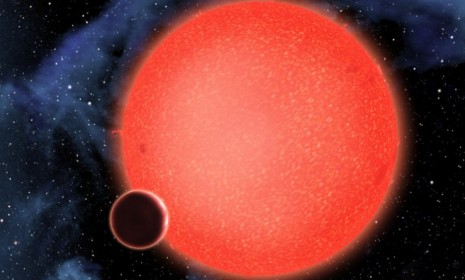'Waterworld': The strange planet covered in a 'big, hot ocean'
Astronomers discover a bizarre new planet that may be home to exotic substances like "hot ice" and "superfluid water"

Maybe it's time for snorkel-equipped spacesuits. NASA scientists have just confirmed an entirely new category of planet just 40 light years away: A "strangely unique" world with a diameter 2.7 times larger than Earth that's covered almost entirely in water. Here, a guide to GJ 1214b, a one-of-a-kind "waterworld":
Why is this planet apparently unique?
Its surface is shrouded in thick, wet fog. In our solar system, planets fit into one of three categories: "Rocky and terrestrial like Mars and Earth, gas giants such as Jupiter and Saturn, and ice giants like Uranus and Neptune," says Fox News. But this new planet doesn't fit neatly into any of these boxes. "GJ 1214b is like no planet we know of," says astronomer Zachory Berta. "A huge fraction of its mass is made up of water."
The Week
Escape your echo chamber. Get the facts behind the news, plus analysis from multiple perspectives.

Sign up for The Week's Free Newsletters
From our morning news briefing to a weekly Good News Newsletter, get the best of The Week delivered directly to your inbox.
From our morning news briefing to a weekly Good News Newsletter, get the best of The Week delivered directly to your inbox.
How much water does this planet have?
Much more than Earth. The findings, published in the Astrophysical Journal, suggest that as much as 50 percent of the exoplanet's mass is water. Its surface temperature is also unusually warm at 450 degrees, says Phil Plait at Discover, or "hot enough to roast a chicken." As Harvard University astronomer David Charbonneau explains: "If you want to describe in one sentence what this planet is, it's a big, hot ocean." Its atmosphere is approximately 10 times thicker than Earth's, creating enormous pressure that together with the intense heat, says Berta, "would form exotic materials like 'hot ice' or 'superfluid water' — substances that are completely alien to our everyday experiences."
Could this "waterworld" host life?
Not human life. And if GJ 1214b can support life, those organisms would be very strange. "This planet will occupy us for years," said Charbonneau. "That's part of what's so exciting about it."
A free daily email with the biggest news stories of the day – and the best features from TheWeek.com
How did astronomers find it?
The planet's location was actually pinpointed in December 2009, when its orbit crossed that of a nearby red dwarf star. At the time, scientists noticed something peculiar about GJ 1214b's glow. When a planet passes in front of a star, its atmosphere typically absorbs some of the star's light (just like Earth's atmosphere absorbs light from the sun). Based on the resulting color, scientists can speculate on the composition of the planet's atmosphere. "Water vapor, for example, has a different impact on a spectrum taken of the star's light, than, say, carbon dioxide," says Phil Plait at Discover.
Sources: BBC News, Discover, Fox News, Mother Nature Network, Toronto Standard
-
 Exploring ancient forests on three continents
Exploring ancient forests on three continentsThe Week Recommends Reconnecting with historic nature across the world
-
 The rise of the spymaster: a ‘tectonic shift’ in Ukraine’s politics
The rise of the spymaster: a ‘tectonic shift’ in Ukraine’s politicsIn the Spotlight President Zelenskyy’s new chief of staff, former head of military intelligence Kyrylo Budanov, is widely viewed as a potential successor
-
 How oil tankers have been weaponised
How oil tankers have been weaponisedThe Explainer The seizure of a Russian tanker in the Atlantic last week has drawn attention to the country’s clandestine shipping network